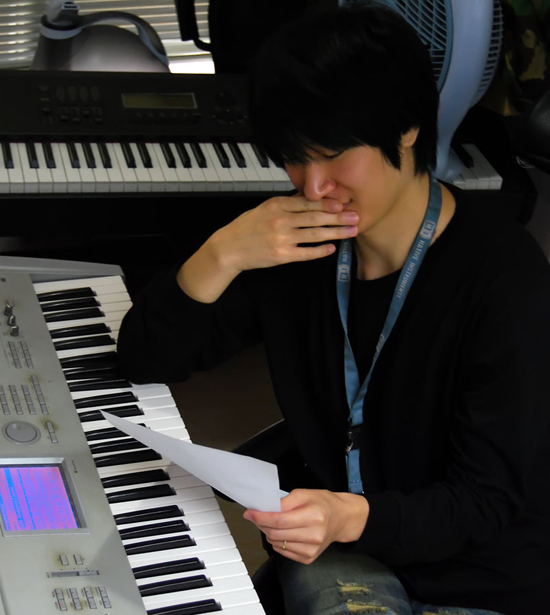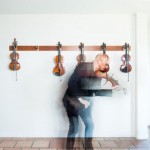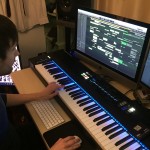We are huge fans of game music coming out of Korea, and you may recall that we were impressed with the La Tale soundtrack that was released online for free last month. We’ve been making a strong effort to get the word out about composers in Korea, and this time around, we’ve got an exclusive interview with DINY/iNID, the lead composer for La Tale.
We talk about his inspirations, his favorite tracks, and the audio direction for La Tale, and touch on his love for the PSG sound source. We also discuss the use of aliases among game composers in Korea, and get a full list of the compoers who worked on La Tale’s soundtrack.
Hit the jump for HyunTaek Yun’s first international interview.
OSV: Hello Mr. Yun. It is a great pleasure to speak with you, as Korean game composers have a lot of fans abroad. I know the audio team working on La Tale was quite large, so tell us your specific role on the team, and tell us about the other members (ESTi, be, jo, NieN) who also created music for the game.
DINY: Hello. I really appreciate the fans of La Tale for their great enthusiasm for the game. I was in charge of the background music and the sound effects as a sound designer for Abio Studios, the development team of La Tale. I would like to introduce the names of the other guest musicians participating in the background music:
ESTi (Jinbae Park)
M2U (Donghwi Shin)
NieN (Goohyun Jung)
Be (Jooeun Hwang)
Electronic Boutique (Jaehyun Shim)
Jo (Kyungnam Jo)
OSV: Perhaps you’d like to tell us a little about your background? What is your background in music, and what other games have you worked on? Do you have a website where we can learn more about you and your music?
DINY: The first step for my career started as I came across AdLib Visual Composer in 1994. I used to work with FM synthesizer SEQ, such as Visual Composer and Note, before I started using MIDI. Since 2002, I have been participating in developing some coterie games. I joined Abio Studios in February 2006 after completing my military service.
You may refer to the following websites:
http://www.success-corp.co.jp/?page/contents/91
http://teamdevice.net/toho_china/kor/
http://teamdevice.net/lost_number/kor/
http://www.latale.com/DataRoom/MusicBox/Default.asp
OSV: What was your approach to the soundtrack for La Tale? Were you given specific instructions, or were you given the freedom to create the kind of music you wanted?
DINY: My objective was to produce La Tale’s background music to be formal yet stylish even though the game itself is a casual online game. I was allowed to try and apply any ideas that came into my mind, such as using new musical instruments and voice sources that I had never tried before. I was also inspired by images of stages and original drawings of the game.
OSV: The first time I heard the music in La Tale, I was convinced that I was hearing the music of soundTeMP. While ESTi is a confirmed member of this talented studio in Korea, are you or any other members of the La Tale audio team members of soundTeMP? Is soundTeMP a popular name in Korea?
DINY: Of the guest musicians who participated in the La Tale project, including myself, only ESTi is a member of soundTeMP. soundTeMP has been well-known for a long time as they started to release their works for PC communication network and PC package games in 1992. It seems they have been regarded as pioneers among the game musicians in Korea. For more information, you can visit http://en.wikipedia.org/wiki/SoundTeMP.
OSV: I noticed that there are a lot of arranged tracks on the La Tale soundtrack. What went into the decision to repeat the themes from the game, especially “MAY be happy” which is featured three times on the soundtrack?
DINY: At the early stage of its development, there was a request from the La Tale game planning team for themes in different styles for the title. In order to respond to this request, I made some different arrangements of ESTi’s “MAY be happy” for each theme of the seasons, like they did for the Princess Maker series.
OSV: A couple of my favorite tracks of yours are “Where am i?” and “Dear. HyeJin,” both of which are very happy and upbeat. Please tell us about these tracks. Is there an interesting story behind them?
DINY: They are also my favorites. We made them with a lot of enthusiasm at the early stages of the project. Some team members and I played them together with the guitar, melody horn, harmonica, recorder and castanets when we went on a picnic one day. The titles are not quite meaningful; I made the title of “Where am I” when I was in a panic due to the tight update schedule. “Dear Hyejin” was named after Ms. Hyejin Han, a member of the game planning team, who requested music for the cash shop.
OSV: One of your most powerful pieces is “올빼미의 성” which features the cries of a wolf alongside driving techno music. What can you tell us about this song?
DINY: As “올빼미의 성” is a stage that reminds players of a Japanese castle of ninja, it was made with the sound of a wolf and the koto (a Japanese traditional musical instrument) with a rhythmic beat to express a Japanese atmosphere and the feeling of a lonely ninja.
OSV: You also created a track titled “I Love PSG!!!,” paying tribute to classic sound source. What was your experience with the PSG, and what made you decide to pay tribute to it with this song in La Tale?
DINY: I have great nostalgia for the PSG sound source because my first game consoles were the Nintendo Famicom and Sega Master System. In La Tale, there is a stage where the graphics are like those of the Famicom’s 8-bit pixel graphics, and because of that, we came up with the idea to produce the background music with the PSG sound source. So we made it with a VSTi which emulates the PSG sound source. Some other pieces, such as “Dear. Hyejin” and “Where am I,” have also been arranged as PSG versions, though they have not been released on the web yet.
OSV: We’ve been told that you also handled the sound effects in the game. What were some of the unique challenges you faced? Was the playful visual style of the game a factor in creating the sound effects?
DINY: Yes, it was. We focused on making the sound effects cute and sweet like the game itself.
OSV: What were some of the tools you and the other team members used to create the music in the game?
DINY: I used to work with CAKEWALK5.0 for DOS until 5 years ago, and I currently use CUBASE3 SX.
OSV: With such a large team, I’m curious to learn about your work environment. Did you each compose your music separately in different locations, or did you work together in person and collaborate on the music? Was it difficult to keep a consistent sound with so many composers involved?
DINY: The project was mostly done in a workroom that was designated for sound production whereas the guest musicians worked in their own areas. The biggest problems were when we lacked ideas due to the tight update schedule, and we ended up having to decide between quality and deadlines.
OSV: The entire soundtrack is currently available for free on the Korean website, but are there any plans to put out a soundtrack in a physical format for collectors abroad?
DINY: I hope that the original soundtrack will be released internationally, but it is under negotiation. It is believed that an OST album may be available after it becomes more popular among more people.
OSV: I’ve noticed that many composers in Korea have alternate aliases, like DINY and iNID in your case. I wanted to ask why composers in Korea don’t release music under their real name, and why do you have two separate names that you release your music under?
DINY: It seems it is kind of a trend; these names are easily recognized and simple. On the other hand, there are a number of musicians who do use their real names in Korea.
OSV: Game music in Korea is always so well produced. It usually tends to be either electronic or pop in style, so I’m curious what you think of game music in Japan and in the West. What do you think of the film style that Western game composers tend to use?
DINY: Asian and Korean game music, which are electronic or pop-style, appear stylish with strong melody lines. I believe the film style of Western games is very appealing and excellent. I would like to learn more about it. However, it has become difficult to draw a line between films and games as the game genres have been diversified and there has been huge development in sound design technology, so it is important to express game music’s own characteristics while following the trend.
OSV: Please tell us what you will be working on next. We look forward to hearing more of your music in the future.
DINY: Nothing special yet. We expect to make some plans for a new project after completing our work on La Tale. Personally, I would like to participate in a hard-boiled detective story like Tantei Jinguji Saburo if I have a chance.
OSV: Congratulations on completing your work on La Tale. Thank you for your time.
DINY: Thank you!










































Nice to hear about you Hyuntaek. The LaTale songs are cute and happy as part of that game world, so it’d be interesting to hear a contrast with more serious detective style music, like you mentioned as a next goal. More PSG styles too!
HyunTaek is a man after my own heart. Not only is LaTale a totally awesome game with great music, but he cited “Tantei Jinguji Saburo” as the type of game he’d like to work on. Sounds like a plan…
Now just find a developer making that sort of digital novel / adventure and be their sound guy! You can do it!!
In fact, I bet a dedicated Korean studio could EASILY surpass the Jinguji Saburo (Jake Hunter) game that was recently released on the DS. That would be sweet.
Love your music! fits the game very well, Some Drum and Bass, Electro, Everything! want to hear more of your music!
That PSG VSTi sounds good, I should look into.
i really respect the music of latale it has something special in it that im really like could listen to it all day